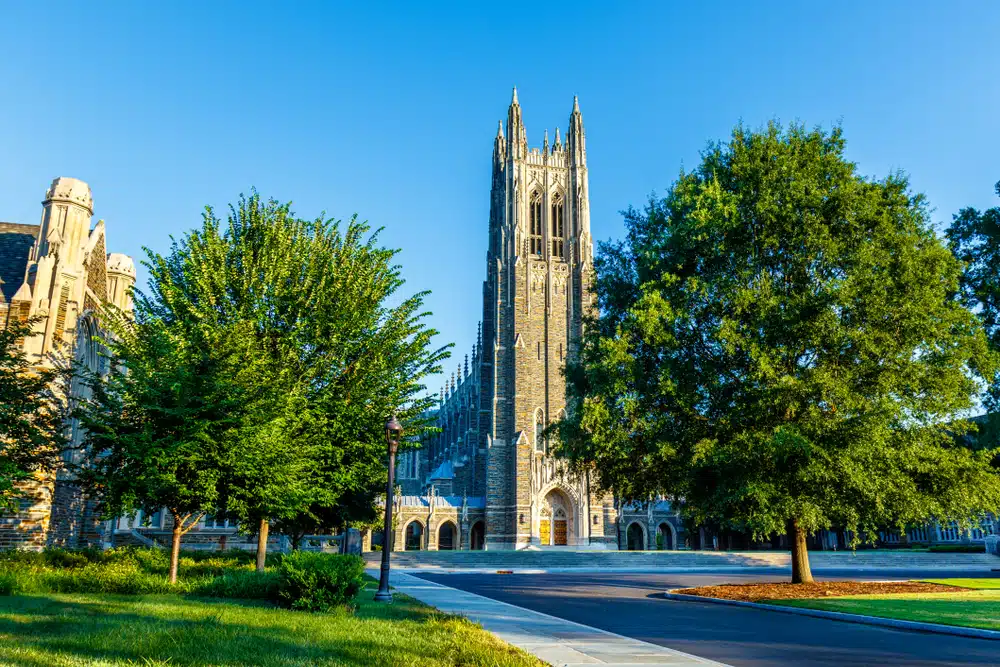Understanding the Size of the Duke Freshman Class
Duke University is renowned for its rigorous academics, vibrant campus life, and esteemed reputation. One crucial aspect of this esteemed institution is the size of its freshman class. Understanding the factors that influence this size is not only fascinating but also essential for comprehending the overall dynamics and impact of Duke University. This article delves into the historical perspective of Duke’s freshman class sizes, examines the factors that influence their size, compares Duke’s freshman class size with other universities, and explores the impact of freshman class size on the university.
The Historical Perspective of Duke Freshman Class Sizes
The Early Years of Duke University
Since its inception in 1838, Duke University has seen substantial changes in the size of its freshman class. In the early years, the university admitted a comparatively small number of students due to limited resources and a focus on providing a more personalized education. With a smaller class size, students enjoyed more individual attention from faculty members and formed close-knit relationships with their peers.
During this time, Duke University was a small, tight-knit community. The campus was characterized by its intimate atmosphere, where professors knew their students by name, and students felt a strong sense of belonging. The smaller class sizes allowed for more interactive and engaging classroom discussions, fostering a deep intellectual curiosity among the students.
Furthermore, the smaller freshman class allowed for more extracurricular involvement opportunities. Students had the chance to participate in a wide range of activities, from academic clubs to sports teams, and significantly impacted campus life.
As the years went by, Duke University began to gain recognition for its academic excellence, attracting students from across the country and even internationally. The university’s reputation grew, and a greater demand for admission came.
The Post-War Era and Expansion
The post-war era marked a significant turning point in Duke’s history. As the nation recovered from the ravages of World War II, Duke capitalized on the growing demand for education by expanding its facilities and programs. This expansion allowed the university to accommodate a larger freshman class, opening doors for more students to benefit from Duke’s exceptional educational offerings.
During this period, the university sought to diversify its student body, embracing students from various backgrounds and regions. This commitment to diversity enriched the academic environment and fostered a more inclusive and vibrant campus culture.
With the increased class size, Duke University offered a more comprehensive range of courses and majors, providing students with more opportunities to explore their academic interests. The larger freshman class also brought in a greater diversity of perspectives, leading to more dynamic and thought-provoking discussions inside and outside the classroom.
Additionally, expanding the university’s facilities allowed for the creation of new student organizations and extracurricular activities. Students now had access to state-of-the-art facilities, such as research labs and performance spaces, further enhancing their overall college experience.
The Modern Era of Duke Freshman Classes
In the present, Duke’s freshman class size has stabilized in response to the university’s resources, capacity, and educational philosophy. The university carefully manages its admissions process to ensure that each admitted student can thrive and receive the attention and support necessary for a transformative educational experience.
While Duke’s educational philosophy values small class sizes and close faculty-student relationships, the university also recognizes the benefits of a diverse and vibrant community. Striking the right balance between these considerations is crucial for maintaining the exceptional quality that Duke is renowned for.
Today, Duke University continues to attract top-tier students from around the world. The university’s commitment to academic excellence and its dedication to fostering a supportive and inclusive environment ensures that each incoming freshman class is composed of talented individuals who will contribute to the vibrant intellectual community that Duke has cultivated over the years.
As the world continues to change and evolve, Duke University remains committed to adapting and providing its students with the best possible education. The university’s history of adjusting its freshman class size to meet the needs of its students is a testament to its ongoing dedication to excellence and innovation.
Duke Freshman Class Size
Duke University extended admission offers to 2,148 high school seniors for the Class of 2027 through its Regular Decision process, commencing notifications at 6 p.m.
These 2,148 students were chosen from an applicant pool of 44,589 for Regular Decision, resulting in an admission rate of 4.8 percent.
The incoming class represents a selection from the larger pool of 49,469 applicants. In December, Duke University admitted 800 students to the Class of 2027 during its Early Decision application cycle, which had 4,880 Early Decision applicants, marking the second-highest number in the university’s history.
Factors Influencing the Size of Duke’s Freshman Class
Duke University, renowned for its academic excellence and global impact, carefully considers various factors when determining the size of its freshman class. These factors include admission policies and standards, university resources and capacity, and broader trends in higher education.
Admission Policies and Standards
Duke’s admission policies and standards are the foundation for selecting the incoming freshman class. The university takes a holistic approach, evaluating each applicant’s academic achievements, extracurricular involvement, leadership potential, and personal qualities. This rigorous assessment ensures that Duke admits a diverse and talented group of students who will contribute to the university’s vibrant community.
By carefully selecting students with exceptional potential, Duke ensures its freshman class represents the best and brightest globally. The university’s reputation for producing future leaders and innovators reflects this commitment to excellence.
Furthermore, Duke aims to balance admitting deserving students and maintaining an optimal class size. Considering the resources available, the university ensures that each student receives the highest quality education and support at Duke.
University Resources and Capacity
Duke’s commitment to providing an exceptional educational experience is another crucial factor in determining the size of its freshman class. The university prides itself on offering small class sizes, personalized attention, and an extensive range of academic and support services.
Before finalizing the freshman class size, Duke carefully assesses its available resources. This assessment includes evaluating faculty capacity and ensuring enough professors to provide individualized instruction and mentorship. Additionally, the university considers its facilities and infrastructure to guarantee students access to state-of-the-art learning environments.
Financial aid is also a significant consideration. Duke strives to ensure that all admitted students have access to the necessary financial resources to pursue their education without undue financial burden. By carefully managing these resources, Duke can maintain its commitment to providing a transformative educational experience for all students.
Trends in Higher Education
As a leading institution in higher education, Duke University closely monitors the broader trends that shape the demand for education. Societal expectations, economic factors, and technological advancements all influence the freshman class size.
By staying attuned to these trends, Duke can adapt its admission strategies to accommodate students most effectively and meaningfully. For example, the university may consider the increasing demand for interdisciplinary programs and create new academic offerings to meet the evolving needs of students.
However, while Duke acknowledges the importance of adapting to external factors, the institution remains steadfast in preserving its rigorous academic standards and commitment to individual attention and support. The university’s dedication to maintaining its core values ensures that each student receives a transformative education that prepares them for success in an ever-changing world.
In conclusion, the size of Duke’s freshman class is influenced by a combination of factors, including admission policies and standards, university resources and capacity, and broader trends in higher education. By carefully considering these factors, Duke University strives to create a diverse and talented community of students who will significantly impact the world.
Comparing Duke’s Freshman Class Size with Other Universities
Ivy League Comparisons
When considering Duke’s freshman class size, comparing it with other prestigious universities is enlightening. Duke’s class size is relatively larger among the Ivy League institutions, allowing for a more diverse and comprehensive academic atmosphere.
At Duke, the larger class size provides students with many benefits. With a more significant number of students, there is a broader range of perspectives and experiences, enriching the learning environment. This diversity of thought fosters lively discussions and encourages students to challenge their beliefs, leading to a more well-rounded education.
Furthermore, the larger class size at Duke allows for a greater variety of academic offerings. Students can choose from various courses, exploring different disciplines and finding their passion. Whether it’s delving into the intricacies of astrophysics or studying the nuances of Renaissance art, Duke’s expansive curriculum caters to a wide range of interests and intellectual pursuits.
Regional University Comparisons
Compared to regional universities, Duke’s freshman class size tends to be smaller. This deliberate choice aligns with the university’s commitment to offering students personalized attention, close faculty-student relationships, and ample opportunities for engagement in research and other academic pursuits.
With smaller class sizes, Duke ensures students receive individualized support and guidance throughout their academic journey. Professors have the ability to truly get to know their students, fostering mentorship relationships that extend beyond the classroom. This personalized approach allows for tailored instruction and a deeper understanding of each student’s strengths and areas for growth.
Moreover, the smaller class size at Duke creates a tight-knit community where students can form lasting connections with their peers. Collaborative projects, study groups, and extracurricular activities thrive in this intimate setting, providing students with a network of support and friendship. The close bonds formed within the Duke community contribute to a sense of belonging and enhance the overall college experience.
In addition, the smaller class size at Duke facilitates engagement in research and other academic pursuits. Students can work closely with faculty members on groundbreaking research projects, gaining hands-on experience and contributing to advancing knowledge in their respective fields. This level of involvement in research sets Duke students apart, equipping them with valuable skills and experiences that will benefit them in their future careers.
The Impact of Freshman Class Size on Duke University
Effects on Campus Life and Culture
The freshman class size profoundly impacts Duke’s campus life and culture. A larger class size contributes to a more vibrant and diverse community, offering students diverse perspectives to engage with and learn from. This diversity enriches the educational experience, fostering a spirit of inclusivity and preparing students for the various realities of the world beyond Duke.
Imagine walking through the bustling campus of Duke University, surrounded by students from all walks of life. A larger freshman class means more opportunities for students to connect with peers from different cultural backgrounds, have unique life experiences and possess various interests. These interactions not only broaden students’ perspectives but also challenge their assumptions and foster a sense of empathy and understanding.
Furthermore, a larger class size encourages the formation of various student organizations and clubs, catering to the diverse interests and passions of the student body. From cultural clubs celebrating different heritages to academic societies exploring niche subjects, the vibrant campus life at Duke is a testament to the positive impact of a larger freshman class size.
Conversely, a smaller class size promotes a close-knit and supportive community, creating an environment where students can form deep and lasting friendships. The intimacy of a smaller class size encourages collaboration and strengthens bonds among students, enhancing their overall collegiate experience.
Imagine being part of a smaller freshman class at Duke University, where you can easily recognize familiar faces and develop close relationships with classmates and professors. In smaller classes, students have more opportunities to engage in meaningful discussions, ask questions, and receive personalized instructor feedback. This individualized attention fosters a sense of belonging and intellectual growth, as students feel valued and supported in their academic pursuits.
Moreover, the close-knit community within a smaller class size often extends beyond the classroom. Students in smaller classes often organize study groups, participate in extracurricular activities together, and support each other through the ups and downs of college life. These strong bonds contribute to camaraderie and create a supportive network long after graduation.
Implications for Academic Quality and Reputation
The size of Duke’s freshman class also has implications for the university’s academic quality and reputation. By carefully balancing admission selectivity and class size, Duke ensures that it can provide each student with the highest caliber of education.
Imagine attending Duke University, renowned for its academic excellence and rigorous curriculum. A smaller class size enables faculty members to offer more individualized attention, fostering meaningful mentorship and guidance. Professors can dedicate more time to understanding each student’s strengths, weaknesses, and academic goals, tailoring their teaching methods to maximize student learning.
Furthermore, smaller class sizes facilitate more interactive and engaging classroom discussions. Students can actively participate, share their unique perspectives, and challenge their peers’ ideas. This dynamic learning environment cultivates critical thinking skills, encourages intellectual curiosity, and prepares students to actively contribute to their fields of study.
On the other hand, a larger class size may present challenges in maintaining the same level of individualized attention and interactive learning. However, Duke University’s commitment to academic excellence ensures that even with a larger freshman class, the university implements strategies such as smaller discussion sections, teaching assistants, and technology-enhanced learning tools to maintain the high-quality education it is known for.
A smaller class size also contributes to Duke’s reputation as a top-tier institution. The personalized approach to education and the exceptional outcomes achieved by students showcase the university’s commitment to nurturing intellectual growth and producing well-rounded graduates. This reputation attracts top-tier faculty, researchers, and students, further enhancing the academic environment at Duke.
Financial Implications for the University
The financial implications of Duke’s freshman class size cannot be overlooked. While admitting a larger freshman class may generate increased tuition revenue, the university must consider the costs of accommodating and supporting a larger student population.
Imagine Duke University’s financial considerations when planning for a larger freshman class. The university must invest in additional faculty members, ensuring that the student-to-faculty ratio remains optimal for effective teaching and mentorship. It also requires expanding and maintaining state-of-the-art facilities, such as laboratories, libraries, and student centers, to meet the growing needs of the student body.
A larger class size also necessitates robust student services, including academic advising, counseling, career development, and extracurricular programming. These services contribute to the holistic development of students and play a crucial role in their success at Duke and beyond.
However, Duke’s commitment to providing a high-quality education comes with financial responsibilities. Balancing the size of the freshman class with the available resources allows Duke to sustain its financial stability while maintaining its commitment to excellence. The university carefully evaluates its economic capacity and ensures that the necessary investments are made to support its students’ academic, social, and personal growth.
Ultimately, the impact of freshman class size on Duke University extends beyond numbers and statistics. It shapes the campus culture, influences the quality of education, and has financial implications that require careful consideration. Duke University continues to navigate these factors to create an environment that fosters intellectual curiosity and personal growth and prepares students to positively impact the world.
Conclusion
Understanding the size of Duke University’s freshman class is essential for comprehending the university’s dynamics, impact, and commitment to excellence in education. The historical perspective, factors influencing class size, comparisons with other institutions, and impact on campus life and culture shed light on the intricate interplay between class size and academic quality.
Duke University’s deliberate approach to class size ensures it can provide a transformative educational experience while maintaining a vibrant and intellectually stimulating community. By carefully balancing the size of its freshman class with available resources and educational philosophies, Duke University continues to create a unique and enriching environment for its students.
If you want to discuss the matter to a greater extent or inquire about college admissions, look no further! Our experts here at AdmissionSight can help you! Here at AdmissionSight, we have over a decade’s worth of experience guiding students through the competitive admissions process to get accepted to the top universities in the world. Feel free to set up an appointment today to book your initial consultation.









































